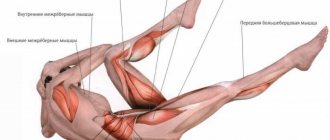I've been running since 2012. Before this I tried to start many times, but always to no avail: I couldn’t last even a week. In 2012, I came across the Couch to 5k training plan for beginners. A year later I ran my first top ten, and two years later I ran my first half marathon.
Now every spring I open the street running season with this program. It helps to gently enter the regime, gradually develops endurance and smoothly prepares for heavy loads.
Before starting exercise, consult your doctor.
How to start running from scratch
The Couch to 5k (C25k) training plan was created by Josh Clark in 1996 when he first started running. As a new runner, he experienced all the difficulties that beginners face:
- stabbing in the side;
- all muscles hurt;
- the heart jumps out of the chest;
- lungs are burning.
9 weeks
during which time you can learn to run without stopping for 30 minutes
Clark was not used to backing down, so he was able to overcome the initial discomfort and did not quit training. However, he understood that these difficulties would scare off most beginning runners: some would decide that running was not for them, others would give up without seeing rapid progress.
Then he decided to develop a training plan that would help him smoothly transition from brisk walking to running, develop endurance and overcome the fear of failure. This is how the Couch to 5k program appeared - “From the couch to 5 km.”
C25k program creator Josh Clark after the Verrazano Half Marathon on April 28, 2018 in New York City. Since 1996, Clark has been regularly training and participating in races.
What sets this program apart from others is the focus on time rather than distance. The beginner is not faced with the task of running as quickly as possible in order to end the torture as quickly as possible. You need to run for a minute, two, five, and it doesn’t matter at what speed, so there’s no point in chasing records.
When the body becomes toned and endurance increases, the running speed will increase by itself.
Runkeeper app
A mega-popular running app with an audience of 45 million people. Running fans don’t need to tell you about it, but we’ll still remember the key features:
- the ability to set long-term goals (lose weight, run a marathon, etc.);
- audio accompaniment - a pleasant voice will tell you about the speed of running, the distance covered, the distance to the finish. This feature can be disabled;
- tests are special tasks that are formed based on the athlete’s performance and are rewarded with prizes. Their implementation is optional;
- ready-made plans for athletes and tools for creating your own training schedule;
- shoe mileage tracking (the ability to find out how many kilometers you have run in your favorite sneakers).
Runkeeper integrates with other health apps (Garmin, Google Fit, Gipis and others). Imports information from heart rate monitors, fitness bracelets, and heart rate sensors. It is possible to track the progress of friends, comment on runs, and encourage each other.
To use all features you need to shell out $5 per month or $20 per year. Premium subscription contents:
- personal training (updated every week);
- detailed statistics of activities (speed on different sections of the route, changes in indicators, etc.);
- the ability to broadcast runs online;
- training plans created by experts.
Everything else is available in the free version.
Download the Strava running app: Android and iOS.
The benefits of running
Of course, you can just take it and run 5 km. But there will be little benefit from such a feat: there will certainly be injuries. Therefore, it is very important to follow the principle of measured exercise, especially if you have never exercised before.
The C25k is based on this principle. The first week consists mainly of walking: in 20 minutes of training you will only have to run 8 minutes. At first, it seems like you can’t learn to run at all. Where is the pain? Where is self-overcoming? Where is the way out of your comfort zone?
However, with each passing week, the running intervals increase and the walking intervals decrease. And the magic begins.
Develops endurance
Each workout will be hard, but a little easier than the last. Ideally, every first workout of the week is difficult, every third is comfortable. This is achieved through a gradual increase in aerobic exercise: the volume of the lungs increases, the heart muscle begins to pump blood more efficiently.
This is what my heart rate graph looks like during interval training. Peaks - heart rate in the running interval. Each subsequent running segment increases your heart rate slightly. Due to this, endurance develops.
Ligaments and muscles are strengthened
By gradually increasing the load, you prepare your joints and ligaments for longer workouts. The elasticity of ligaments increases, blood supply to muscles and joints improves. Oxygen and nutrients become more available.
Motivation is maintained
When you see only 8 minutes of running in the plan, there are no “I can’t” or “this is not for me.” The fear of not being able to cope recedes, and is replaced by the desire to quickly tick off the training box.
The structure of any workout:
- Light warm-up or warm-up run. It is necessary for your body to “start up” so that the cardiovascular system adapts to the increasing volume of blood that the body begins to produce to supply it with oxygen. This will prepare the body for the upcoming load, allowing it to be better perceived and absorbed.
- Main part.
- Cool down, stretching, slow running, “cooling down the body.” It must be done until the pulse returns to normal. An important part that allows you to smoothly and carefully “slow down” the body, gently returning all its systems to a state of rest.
It's never too late and never too early to start training through running. Running is an extremely democratic sport, accessible at any age. Before starting any training cycle, be sure to consult with your doctor, get examined and get clearance to run.
Author: Alexander Kozlov (c)
C25k training plan
The program is designed for 9 weeks of regular training 3 times a week. By the end of this period, you will be able to run for half an hour without breaking a step - this will be approximately 5 km.
Training plan, PDF
Before the start of the workout and at the very end, a warm-up and cool-down is expected - walking at a brisk pace for 5 minutes. Don't neglect warming up: brisk walking increases your heart rate, prepares your body for further stress and reduces the risk of injury.
Green segments are running, yellow segments are walking, blue segments are warm-up and cool-down.
Types of training
Runners should clearly understand what each day’s training is for; they calculate the amount of time used to achieve the first significant results. It is also necessary to have an understanding of the body's reaction to various loads, which will help prevent overuse and injury.
There are trainings:
- functional (aimed at developing different muscle groups - push-ups, lunges, abs, pull-ups);
- running (train the muscles and ligaments involved in running);
- tempo (fast, uniform, high-intensity running at the anaerobic limit);
- long (strengthens muscle groups and ligaments, as well as the nervous system).
For good health
It is better for a beginner to run at the same time, 3-4 days weekly. A rest day is recommended between workouts. First, alternate walking and light running, strengthening the respiratory system. Then they move on to full 20-minute runs, shortening walking breaks. Preparation takes about two months.
If the goal of exercise is to lose weight, exercise should be regular. Jogging is needed every day. They run, periodically accelerating: starting with walking, switching to a calm run , then sharply accelerating and slowing down again. Such intervals alternate for half an hour. When drawing up a running training schedule, take into account that weight loss is more successful when exercising in the evening.
Morning and afternoon running develop muscles, strengthen blood vessels and the heart, and train breathing.
Table No. 1. 10 week program for beginners
| A week | Running schedule | Duration |
| 1 | 60 seconds – running 120 seconds – walking | 21 minutes |
| 2 | 120 seconds – running 120 seconds – walking | 20 minutes |
| 3 | 180 seconds – running 120 seconds – walking | 20 minutes |
| 4 | 300 seconds – running 120 seconds – walking | 21 minutes |
| 5 | 360 seconds – running 90 seconds – walking | 20 minutes |
| 6 | 480 seconds – running 90 seconds – walking | 18 minutes |
| 7 | 600 seconds – running 90 seconds – walking | 23 minutes |
| 8 | 720 seconds – running 60 seconds – walking 480 seconds – running | 21 minutes |
| 9 | 900 seconds – running 120 seconds – walking 300 seconds – running | 21 minutes |
| 10 | 1200 seconds – running No walking | 20 minutes |
Note:
- frequency of training – 3-5 days weekly with a preliminary 6-10-minute warm-up.
Download the 10-week Beginner Running Program schedule:
Sprint running
This is covering a distance from 60 to 400 meters, varieties are relay races 4 x 100 or 4 x 200 meters and hurdles . Its popularity is due to its dynamism, high speed and intense competition.
Sprint running is one of the most difficult sports disciplines. In a short period of time, the runner gives his all, and the winner runs the distance at the highest speed, which cannot be reduced until the finish line.
You won't be able to sprint without proper training. After all, it puts increased pressure on the heart and forces the body to find alternative sources of energy.
Specifics of classes: week - according to plan, three days before the race - intense physical education, cool-down and stretching, but with less tension.
Main types of exercises:
- running at maximum walking intensity (in place);
- jumping on 1 leg;
- intense swinging of arms (as when running);
- hip lift;
- jumping over balls.
Table No. 2. Training program for sprinters
| № | Exercise name | Number of times | |||
| For men | Women | ||||
| Group I | Group II | Group I | Group II | ||
| (beginners) | (experienced) | (beginners) | (experienced) | ||
| 1 Week | |||||
| 1 | 150 m. with MVS 70% | 1-2 | 2-3 | 1 | 2 |
| 2 | 100 m. with MVS 80% | 1-2 | 2-3 | 1 | 2 |
| 3 | 50 m. with MBC 80% | 1-2 | 2-3 | 1 | 2 |
| 2 week | |||||
| 1 | Running up stairs (~30 steps) with max. frequency | 3 | 4 | 2 | 3 |
| 2 | running up stairs (~30 steps) with max. long stride | 3 | 4 | 2 | 3 |
| 3 | 40 m running with jumps (MVS 70%) | 1 | 2 | 1 | 2 |
| 4 | 60 m running with marker jumps | 1 | 2 | 1 | 2 |
| 3 week | |||||
| 1 | Jumping forward from a place | 7 | 10 | 5 | 8 |
| 2 | Jumping on both legs – 30 m. | 1 | 2 | 1 | 2 |
| 3 | Jumping on 1 leg | 5 | 7 | 3 | 6 |
| 4 | Jumping up with max. rebound | 41 | 81 | 31 | 66 |
| 5 | Jumping rope | 52 | 102 | 62 | 122 |
| 6 | Full squat jumps | 10x2 | 20x2 | 7x2 | 16x2 |
| 4 week | |||||
| 1 | Squats on 1 leg (“pistol”) | 3x2 | 4x2 | 3x2 | 4x2 |
| 2 | Barbell squats (70% max weight) | 5x2 | 7x2 | 4x2 | 6x2 |
| 3 | Lunges with a barbell | 5 | 7 | 4 | 6 |
| 4 | Half squat with barbell | 5 | 7 | 4 | 6 |
| 5 week | |||||
| 1 | Cross | 1 | 2.5 | 1 | 2 |
| week 6 | |||||
| 1 | 50 m interval running with MVS, 50 m jogging. Total length – 400 m. | 1 | 2 | 1 | 2 |
| 2 | 100 m. with MVS 80% | 3 | 5 | 2 | 3 |
| week 7 | |||||
| 1 | Running up ~30 steps with MVS | 2 | 3 | 2 | 3 |
| 2 | 150 m uphill run with MBC 70% | 2 | 4 | 2 | 3 |
| 3 | Shuttle run 4x20 | 1 | 2 | 1 | 2 |
| 4 | 60-80 m running with weights | 1 | 2 | 1 | 2 |
| 8 week | |||||
| 1 | 30 jumps on 1 leg with progression | 2 | 3 | 1 | 2 |
| 2 | 30 jumps on 2 legs with progression | 2 | 3 | 1 | 2 |
| 3 | 30 jumping jacks with progression | 2 | 3 | 1 | 2 |
| 4 | "pistol" | 7 | 10 | 6 | 8 |
| 5 | squats with barbell, max. weight – 70% | 6 | 9 | 5 | 7 |
| Week 9 | |||||
| 1 | 300 m. with MVS 70% | 1 | 1 | 1 | 1 |
| 2 | 250 m. with MVS 70% | 1 | 1 | 1 | 1 |
| 3 | 200 m. with MBC 70% | 1 | 2 | 1 | 2 |
| 4 | 150 m. with MVS 70% | 1 | 2 | 1 | 2 |
| 10 week | |||||
| 1 | Sports games (with ball) | 40 minutes | 60 minutes | 40 minutes | 60 minutes |
| 2 | Cross | 1.5 | 3 | 1.5 | 2.5 |
Note:
- MVS - maximum speed
- Max. – maximum
Download training program for sprinters
Practice 5 days a week for 2 weeks. The load is added as the quality of physical fitness improves. They follow a special diet. You also need to monitor your pulse.
For long distances
This is the most popular type of relay race (from 3 to 10 kilometers). To achieve high results, speed endurance and well-calculated speed are required. This kind of running puts a lot of stress on the cardiovascular system, so training and choosing the right technique are necessary.
Table No. 3. Weekly training program
| Day | Type of occupation |
| 1 | Cross-country 15 km at a variable pace with accelerations 4-5 times 1 km at a speed of 3 minutes. General developmental 15 minute exercises and stretching. |
| 2 | A steady 15-18 kilometer run with a heart rate of up to 170 beats/min. (speed – 4.10-4.20 per 1 km). 20-minute exercises for general development. |
| 3 | 14-16 kilometer run with acceleration of 4-5 km (speed – 3.10-3.20 per 1 km), heart rate – 170 beats/min., rest. distance – 4.00-4.10 per 1 km. 20 minute exercises. |
| 4 | 30-40 minute sports games. 20 minute warm-up in pairs. Accelerations 10x100 m. 20-minute hurdles and running. Jumping (80-100 push-offs). Strength training for calves and feet. |
| 5 | 3-4 kilometer warm-up run, 15 minute outdoor switchgear. Accelerations 6x100 m and 4x150 m. Repeated running 3-6 times at 1000-3000 m over rough terrain. A slow 2 kilometer run. |
| 6 | 18-20 kilometer uniform cross-country (speed 4.20 per 1 km), with a heart rate of 150-160 beats/min. |
| 7 | Rest. |
Download the weekly training program
How to train
When I first started training with this program in 2012, I ran with a sports timer. At home, I had a training program hanging on the wall, in which I noted each run. At the beginning of each week, I set the intervals on the timer according to my training plan. Then I got tired of fiddling with the timer, and for some time I just ran by the clock.
Sports timer for interval training. It is inconvenient that it needs to be re-programmed every time.
Later, I started training with the C25k phone app. It is free, there is a paid version for 379 rubles without advertising. The application is much more convenient than a simple timer, because it does not need to be specially programmed. There are voice instructions in English: the application will tell you when to start running and when to take a step. The only inconvenience is that you have to run around with your phone.
The first screen of the application. You can select a training day at the bottom, and a brief description of the workout will appear at the top.
The app will tell you when to start running and when to take a step. Warm-up and cool-down are also included in the workout.
Completed workouts are marked with check marks. If necessary (for example, if you get sick), they can be repeated again: then the new workout will be recorded over the old one.
Advertising in the free version is not very intrusive: a small banner at the bottom of the screen during training and an advertising screensaver after.
The principle of progression of loads in running
The principle of load progression in running states that objective training stress should constantly increase. The volume of the training load must increase.
Increasing your training load is a factor that underlies muscle gain and weight loss in running. Most beginners progress in the first 3-4 weeks, when the body adapts to the load, after which progress ends. We train according to static programs without understanding that at each training session (perhaps once every 2-4 training sessions) the load should increase. Increasing objective (subjective sensations from the severity of the workout should remain at the same level) training stress is the key to progress at maximum speed.
Let's look at correct and incorrect running programs from the point of view of the principle of load progression.
Beginners usually train like this:
Workouts No. 1-30
| Exercise | Duration |
| Jogging at an easy pace | 15 minutes |
It often doesn’t get to the 30th workout due to lack of visibility of progress. Regular 15-minute runs tone your muscles, help you lose weight, improve your health and stay fit. But this “system” does not follow the principle of progression of loads - the key to creating an effective running program.
Running workouts should look like this:
Running workout #1
| Exercise | Duration in minutes |
| Jogging at an easy pace | 10 |
Running workout #2
| Exercise | Duration in minutes |
| Jogging at an easy pace | 12 |
Running workout #3
| Exercise | Duration in minutes |
| Jogging at an easy pace | 14 |
Running workout #4
| Exercise | Duration in minutes |
| Jogging at an easy pace | 15 |
Running workout #5
| Exercise | Duration in minutes |
| Jogging at an easy pace | 17 |
Running workout #6
| Exercise | Duration in minutes |
| Jogging at an easy pace | 20 |
Running workout #7
| Exercise | Approaches | Duration in minutes | Rest between sets in minutes | Rest after exercise in minutes |
| Jogging at an easy pace | 1 | 20 | — | 4 |
| Sprint running | 2 | 100 meters | 1 | — |
Running workout #8
| Exercise | Approaches | Duration in minutes | Rest between sets in minutes | Rest after exercise in minutes |
| Jogging at an easy pace | 1 | 20 | — | 4 |
| Sprint running | 3 | 100 meters | 1 | — |
Running workout #9
| Exercise | Approaches | Duration in minutes | Rest between sets in minutes | Rest after exercise in minutes |
| Jogging at an easy pace | 1 | 23 | — | 4 |
| Sprint running | 3 | 100 meters | 1 | — |
Running workout #10
| Exercise | Approaches | Duration in minutes | Rest between sets in minutes | Rest after exercise in minutes |
| Jogging at an easy pace | 1 | 25 | — | 4 |
| Sprint running | 4 | 100 meters | 1 | — |
The continuation of this scheme can be found below.
The difference between the correct and incorrect running program is that, with the same initial data, training according to the second scheme built more muscle, burned more fat, brought the functioning of the hormonal system to a new level, and improved the functioning of the lymphatic system. The evaluation criterion of the training program is the result . A dynamic scheme that takes into account the principle of progression of loads is tens of times superior to static programs. And the longer an athlete trains, the more visible the difference is. Static programs only work for beginners who remember physical activity only from school physical education lessons.
Running heart rate
If you want to progress in running, I recommend getting a heart rate monitor. Then, in addition to sensations, you will be able to focus on your pulse.
- The beginning of the workout usually takes place in the fat-burning zone - approximately 50-70% of the maximum heart rate. This is the warm-up and cool-down area.
- A running workout that is adequate for your fitness level should take place in the aerobic zone - this is approximately 70-85% of your maximum heart rate. This is a good working workout when you exercise with effort, but not to the point of stars in your eyes.
- Maximum effort occurs when your heart rate rises to 85-90% of maximum - this is the anaerobic zone in which you progress. Such peaks should not be frequent, and under no circumstances should the heart rate be allowed to remain in this zone throughout the entire workout.
When working out I use the FitBit Charge 2 fitness tracker
It tracks heart rate, distance, average speed and number of steps
After each workout, the FitBit app syncs with the tracker and shows statistics
Track your progress: mark the days you trained on your calendar, record your distance, monitor your heart rate. This way you will see how much easier it is for you to do things that previously seemed impossible. There is no such thing as too much motivation.
Strava running app
One of the most popular apps for runners, the social network is a simple and convenient way to track your activity. Here's what's inside::
- tracking distance traveled, speed, calories burned and weight of the athlete;
- the ability to comment on the successes of other people, rate them, and share images;
- comparison of results at different stages of the run;
- integration with Instagram - photos from the social network are automatically transferred to your personal profile on Strava;
- import information from pacemakers, fitness bracelets, pulse sensors.
All important Strava features are available in the free version. Subscribers to the service are offered enhanced social features and in-depth analysis. Everyone knows and writes about Strava. If you don’t believe me, you can look through any book about running. In our opinion, the most interesting selection of books about running is on the Mann, Ivanov and Ferber website.
Download the Strava running app: Android and iOS.
Running shoes
If you decide to start running, spare no expense and buy special running sneakers. This way you will protect your knees from injury and be able to progress faster.
I started running at Reebok, continued at Nike and eventually came to Asics. I currently have three pairs of running shoes.
Multi-colored Asics Noosa Tri 10 - triathlon shoes. I liked it because of the hard heel that perfectly holds the heel. Now I run in them if I have a muddy race ahead: through the forest or through the sand. They are old, don't feel sorry for them.
The blue Asics Gel-Kayano 23 has excellent cushioning and fit. When the time comes to change sneakers, I will first consider this newer model.
The black and orange Asics Gel-Cumulis 18 G-TX is an all-weather running shoe with a waterproof Goro-Tex membrane. I bought these for rainy days. In addition to running, I often wear them in the off-season: the membrane protects from rain and wind. It is not recommended to run in them all the time, because the protective membrane prevents the foot from breathing, but it is an excellent option for bad weather.
Blue ones are the most favorite running shoes for running on clean trails - asphalt, tiles, rubber tracks in parks. The black and orange ones are stiffer than the Kayano, but just as comfortable.
What else to pay attention to
Excess weight
If you are over 10 kg overweight, start with regular brisk walks. Walking will also increase your endurance without stressing your joints and increase your lung capacity.
Proper breathing when running
Try to breathe deeply and slowly - three to four steps at a time. Inhale through your nose, exhale through your mouth. If you have a tingling sensation in your side, slow down, breathe even slower and deeper, and massage your sore side. This sensation occurs when the liver and spleen become engorged due to increased circulation. Due to deep breathing, the lungs open up more and put pressure on the organs, promoting the outflow of blood.
My trainer gave me another piece of advice to avoid pain in my side: you need to inhale for three counts and exhale for four counts. So you inhale first on the right and then on the left leg, and while inhaling, the lungs press on the liver and spleen alternately.
Warm up before running
In addition to 5 minutes of brisk walking before training, be sure to do a joint warm-up:
- rotation of the head, arms, pelvis;
- circular movements of the knees and feet - everything we did at school in physical education.
This will prepare your joints for impact and reduce the likelihood of injury.
Post-workout stretching
After walking for 5 minutes at a brisk pace, you need to do some stretching. Any routine for runners or yoga exercises will do. Focus on the front and back of your thighs, bend forward, and pull your toes toward you. The better you stretch, the faster your muscles will return to normal after training.
If you get sick
Take a break from training for a week or two. During this time, the body will recover from the effects of the disease, and you will be able to train at full strength. In your training plan, go back a week and repeat lighter workouts to gradually adapt to the load. If the illness is prolonged, it would be better to start the program again.
Run at a convenient time
I trained hard in the morning for a long time, and every run was hard labor for me. Over the past few years, I have been running in the evenings: the heat of the day has subsided, there is no scorching sun, running is easy and pleasant. If you're just starting to run, never run in the heat at midday, even if that's the only time possible.
Don't shorten the program
Don't try to fit your program into less time by eliminating rest days between running sessions. The body needs to recover after training, and the most that can be done is to add other workouts in between running days: yoga, gym, physical training, cycling, swimming.
Running technique
Photo: Stage 7 Photography / Unsplash
Beginners adapt to the loads faster and get better results when they follow the correct running technique.
- Start your workout with a warm-up: walk around, do simple exercises - swinging your arms and legs, rotating your torso, bending, turning. This will get your blood flowing and your muscles warm.
- Do not strain your body while running - this does not affect the effectiveness of the workout, but it does take a lot of energy. The rule will help in long-distance running, when you need to properly distribute the load.
- Land on the front of your foot, with your supporting leg exactly under your center of gravity and your fly leg under your pelvis.
- Don't lower your head: look forward, even if there are no obstacles under your feet. Turning the head while moving takes away excess energy, creates stress and even leads to loss of consciousness.
- Bend your torso forward - this will relieve tension from the spine and save energy.
- Breathe rhythmically: inhale briefly through your nose and exhale twice as long through your mouth.
- Monitor your pulse. The norm while running is 130 beats per minute. This will allow you to correctly regulate the load: speed up or slow down.
- Finish your workout with stretching. Walk for a few minutes, and then do any set of stretches for the front and back of your thighs. This will help your muscles recover faster after training.
Memo
- Before starting exercise, consult your doctor.
- A training plan is your best friend. Stick to it: don’t skip rest days, don’t chase speed.
- Track your progress: mark your running days on your calendar and monitor your heart rate.
- Don't neglect warming up before and cooling down after training. Warming up will prepare your joints before running, and stretching will help your muscles recover faster.
- During training, try to stick to the same running pace: suppress the desire to start running quickly. To increase endurance, it is better for your heart rate to rise gradually.
- For running on the street, be sure to purchase running shoes: every manufacturer has models for running.
- Incorporate other types of activity between workouts. Strengthen your back and abdominal muscles: all kinds of planks, crunches and push-ups will do.
Do you want to have a beautiful body? Then, in addition to jogging, you need training. Especially for this, we have put together simple and effective sets of exercises on the street and in the gym.
Enter your email and click the download button ↓
How to train after finishing the program?
Having completed the fifth week of training, you are ready to independently plan your training. Perform 3 runs per week, gradually increasing the pace and length of the distance.
Try running 1 kilometer at 30% pace without starting to jog. If it works, increase the distance by 100 meters. In a month you will be able to run 2 kilometers at a high pace!
If you failed to run 1 kilometer without rest, there is no reason to be upset! Run 500 meters without stopping. Everyone's reaction to stress is different, so the development of endurance occurs differently. Having overcome the barrier, the result will grow rapidly.
Run 200 meter segments. This is the next step in developing endurance and a good fat burner. Run 3 segments after your main workout. If you run around the stadium, you can perform segments of alternating running: 200 meters of acceleration and the rest of the circle jogging.
If you feel that 3 kilometers is an easy task, make the workout more difficult. While running the distance, stop and do 20 push-ups or squats, and do static exercises. You can use weights weighing 1-3 kilograms, which are attached to your feet. It can also create additional stress on your arms and shoulders.
Important. After each workout, stretch to make your muscles stretch and look attractive.










